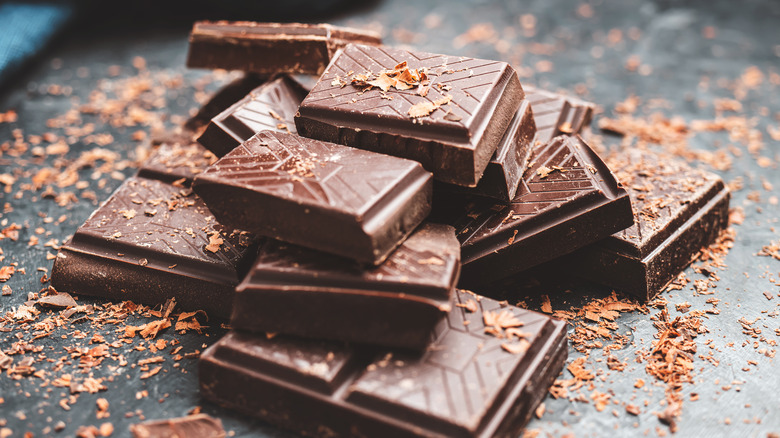Is There Really A Difference Between Bittersweet And Semi-Sweet Chocolate?
Everyone loves chocolate, but cooking with it can sometimes be confusing. After all, there are all sorts of varieties for sale: dark chocolate, white chocolate (yes, white chocolate is actually chocolate), milk chocolate, and even baker's chocolate. All have varying levels of sweetness and chocolate flavor, and all have different effects on what you're making. But two varieties seem similar enough that people are often left wondering if they're even different at all: bittersweet chocolate and semi-sweet chocolate.
There absolutely are key differences between bittersweet and semi-sweet chocolate, and it comes down primarily to cacao percentage, with semi-sweet having 10% less cacao than bittersweet — a swap that leads to several noticeable changes. However, the two are also so similar that you can swap one for the other in a recipe. While it would change the flavor somewhat, it's a minor enough variance that it really just comes down to personal preference.
Bittersweet chocolate has just a bit more cacao than semi-sweet
Bittersweet chocolate and semi-sweet chocolate are extremely similar; they're much closer in taste than any other two chocolate varieties. But they're still noticeably different, and that comes down to the cacao percentage in each: Bittersweet chocolate is made up of 70% cacao, while semi-sweet is only made of 60% cacao. Though these are close numbers (and you can swap one for the other without destroying your recipe), they're different enough that they can't be classified as exactly the same.
It's important to understand what that cacao percentage actually means. Chocolate generally consists of three things: cacao, cocoa butter, and sugar. A chocolate's cacao percentage is pretty self-explanatory: it's what percentage of the chocolate consists of cacao. So semi-sweet chocolate has 10% more sugar and cocoa butter relative to bittersweet chocolate, which means it's going to be sweeter. Bittersweet chocolate, meanwhile, is going to have a slightly deeper and more bitter flavor.
That's not actually the only difference between the two. Because of the inclusion of more cocoa butter, semi-sweet chocolate is going to be slightly creamier and less crumbly than bittersweet. There's also a visible difference: More cacao content means bittersweet is going to be noticeably darker than semi-sweet.
Chocolate sweetness is also influenced by the type of cacao
Keep in mind also that the sweetness of the chocolate doesn't simply come down to whether it's bittersweet, semi-sweet, milk, or even dark. The other important factor here has to do with which type of cacao fruit your chocolate came from. In the case of most mass-produced chocolate, this is going to be forastero — the most common kind of cacao, but also the most bitter. If you can get your hands on chocolate made from trinitario or even criollo,the rarer varieties of cacao, the taste is going to be noticeably smoother and sweeter.
So, would a criollo bittersweet be sweeter than a forastero semi-sweet? Probably, although it still comes down to the individual batches themselves. Some of this involves eyeballing it, or even tasting the chocolate yourself. It really just comes down to what you are personally looking for, and paying attention to what your particular brand of chocolate tastes like.


